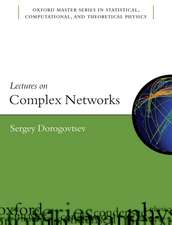Introduction to Artificial Life
Autor Christoph Adamien Limba Engleză Paperback – 18 apr 2013
Preț: 399.50 lei
Nou
Puncte Express: 599
Preț estimativ în valută:
76.45€ • 80.02$ • 63.63£
76.45€ • 80.02$ • 63.63£
Carte tipărită la comandă
Livrare economică 31 martie-14 aprilie
Preluare comenzi: 021 569.72.76
Specificații
ISBN-13: 9781461272311
ISBN-10: 1461272319
Pagini: 396
Ilustrații: XVIII, 376 p.
Dimensiuni: 178 x 254 x 25 mm
Greutate: 0.69 kg
Ediția:Softcover reprint of the original 1st ed. 1998
Editura: Springer
Colecția Springer
Locul publicării:New York, NY, United States
ISBN-10: 1461272319
Pagini: 396
Ilustrații: XVIII, 376 p.
Dimensiuni: 178 x 254 x 25 mm
Greutate: 0.69 kg
Ediția:Softcover reprint of the original 1st ed. 1998
Editura: Springer
Colecția Springer
Locul publicării:New York, NY, United States
Public țintă
ResearchCuprins
1 Flavors of Artificial Life.- 1.1 Whither a Theory of the Living State?.- 1.2 Emulation and Simulation.- 1.3 Carbon-Based Artificial Life.- 1.4 Turing and von Neumann Automata.- 1.5 Cellular Automata.- 1.6 Overview.- 2 Artificial Chemistry and Self-Replicating Code.- 2.1 Virtual Machines and Self-Reproducing CA.- 2.2 Viruses and Core Worlds.- 2.3 The tierra System.- 2.4 avida, amoeba, and the Origin of Life.- 2.5 Overview.- 3 Introduction to Information Theory.- 3.1 Information Theory and Life.- 3.2 Channels and Coding.- 3.3 Uncertainty and Shannon Entropy.- 3.4 Joint and Conditional Uncertainty.- 3.5 Information.- 3.6 Noiseless Coding.- 3.7 Channel Capacity and Fundamental Theorem.- 3.8 Information Transmission Capacity for Genomes.- 3.9 Overview.- 4 Statistical Mechanics and Thermodynamics.- 4.1 Phase Space and Statistical Distribution Function.- 4.2 Averages, Ergodicity, and the Ergodic Theorem.- 4.3 Thermodynamical Equilibrium, Relaxation.- 4.4 Energy.- 4.5 Entropy.- 4.6 Second Law of Thermodynamics.- 4.7 Tèmperature.- 4.8 The Gibbs Distribution.- 4.9 Nonequilibrium Thermodynamics.- 4.10 First-Order Phase Transitions.- 4.11 Overview.- 5 Complexity of Simple Living Systems.- 5.1 Complexity and Information.- 5.2 The Maxwell Demon.- 5.3 Kolmogorov Complexity.- 5.4 Physical Complexity and the Natural Maxwell Demon.- 5.5 Complexity of tRNA.- 5.6 Complexity in Artificial Life.- 5.7 Overview.- 6 Self-Organization to Criticality.- 6.1 Self-Organization and Sandpiles.- 6.2 SOC in Forest Fires.- 6.3 SOC in the Living State.- 6.4 Theories of SOC.- 6.5 Overview.- 7 Percolation.- 7.1 Site Percolation.- 7.2 Cluster Size Distribution.- 7.3 Percolation in 1D.- 7.4 Higher-Dimensional Euclidean Lattices.- 7.5 Percolation on the Bethe Lattice.- 7.6 Scaling Theory.- 7.7 Percolationand Evolution.- 7.8 Overview.- 8 Fitness Landscapes.- 8.1 Theoretical Formulation.- 8.2 Example Landscapes.- 8.3 Fractal Landscapes.- 8.4 Diffusive and Nondiffusive Processes.- 8.5 RNA Landscapes.- 8.6 Fitness Landscape in avida.- 8.7 Overview.- 9 Experiments with avida.- 9.1 Choice of Chemistry.- 9.2 A Simple Experiment.- 9.3 Experiments in Adaptation.- 9.4 Experiments with Species and Genetic Distance.- 9.5 Overview.- 10 Propagation of Information.- 10.1 Information Transport and Equilibrium.- 10.2 The Artificial Life System sanda.- 10.3 Diffusion and Waves.- 10.4 Comparison: Theory and Experiment.- 10.5 Overview.- 11 Adaptive Learning at the Error Threshold.- 11.1 Information Processing at the Edge of Chaos.- 11.2 Adaptation to Computation in avida.- 11.3 Eigen’s Error Threshold.- 11.4 Molecular Evolution as an Ising Model.- 11.5 The Race to the Error Threshold.- 11.6 Approach to Error Threshold in avida.- 11.7 Overview.- A The avida User’s Manual.- A.1 Introduction.- A.2 A Beginner’s Guide to avida.- A.3 Time Slicing and the Fitness Landscape.- A.4 Reproduction.- A.5 The Virtual Computer.- A.6 Mutations.- A.7 Installing avida.- A.8 The Text Interface.- A.9 Configuring avida Runs.- A.10 Guide to Output Files.- A.11 Summary of Variables.- A.12 Glossary.- References.
Caracteristici
The first book specifically designed for advanced courses in Artificial Life Of interest to both academic research and professional audiences Brings together a theory for understanding the dynamics of systems of self-replicating information together with the experimental results
















